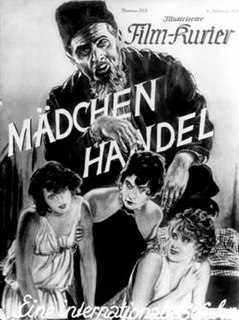Related Research Articles
The November Group was a group of German expressionist artists and architects. Formed on 3 December 1918, they took their name from the month of the German Revolution.

Friedrich Rudolf Klein, better known as Rudolf Klein-Rogge, was a German film actor, best known for playing sinister figures in films in the 1920s and 1930s as well as being a mainstay in director Fritz Lang's Weimar-era films. He is probably best known in popular culture, particularly to English-speaking audiences, for playing the archetypal mad scientist role of C. A. Rotwang in Lang's Metropolis and as the criminal genius Doctor Mabuse. Klein-Rogge also appeared in several important French films in the late 1920s and early 1930s.

George Schnéevoigt was a Danish film director, cinematographer, and actor of the 1910s to early 1940s. Schnéevoigt was born in Copenhagen, Denmark, on 23 December 1893 to the Finnish-born photographer and actress Siri Schnéevoigt, and Hermann Friedrich Fischer. He was the father of photographer Alf Schnéevoigt.

Monica Ingeborg Elisabeth "Mona" Mårtenson was a Swedish film actress. She appeared in 28 films between 1923 and 1949. She was born and died in Stockholm, Sweden.

Paul Richter was an Austrian film actor. He owed his great popularity in German films of the silent era largely to the directors Joe May and Fritz Lang.

The Queen Was in the Parlour is a 1927 Anglo-German silent drama film directed by Graham Cutts and starring Lili Damita, Louis Ralph and Paul Richter. It was based on the Noël Coward play The Queen Was in the Parlour. Its German title was Die letzte Nacht.

White Slave Traffic is a 1926 German silent thriller film directed by Jaap Speyer and starring Rudolf Klein-Rogge, Erich Kaiser-Titz, and Fritz Alberti. When a Berlin nightclub worker moves to Budapest to take up a job that has been arranged for her, she finds herself being kidnapped by white slave traffickers. She is eventually rescued from a brothel in Athens. The film opened with a warning from a group committed to combating white slavery, but the film's sensationalist tone provoked controversy. In Britain it was refused a licence by the British Board of Film Censors although it is possible it had some private screenings. One contemporary review described it as "crude melodrama on an unpleasant subject".

Peter the Pirate, also known in English as The Sea Wolves, is a 1925 German silent historical adventure film directed by Arthur Robison and starring Paul Richter, Aud Egede-Nissen, and Rudolf Klein-Rogge. It was based on a novel by Wilhelm Hegeler. Leni Riefenstahl was offered the role of female lead by producer Erich Pommer, but after doing a screen test she eventually turned it down.
The Woman in the Advocate's Gown is a 1929 Norwegian-German silent drama film directed by Adolf Trotz and starring Aud Egede-Nissen, Paul Richter, and Fritz Kortner. The screenplay was based on Peter Bendow's novel Frk. Statsadvokat, published in 1929. The film's art direction was by Hans Jacoby.
The Pink Diamond is a 1926 German silent comedy-drama film directed by Rochus Gliese and starring Xenia Desni, Rudolf Klein-Rogge and William Dieterle. It was based on the play Karriere by Richard Kepler. The film's sets were designed by Egon Eiermann. It premiered on 8 March 1926.
The Secret of Johann Orth is a 1932 German historical drama film directed by Willi Wolff and starring Karl Ludwig Diehl, Ellen Richter and Paul Wegener.
The Stone Rider is a 1923 German silent drama film directed by Fritz Wendhausen and starring Rudolf Klein-Rogge, Lucie Mannheim and Gustav von Wangenheim.
Lord of the Night is a 1927 German silent thriller film directed by Carl Heinz Wolff and starring Kurt Brenkendorf, Aud Egede-Nissen, and Rudolf Klein-Rogge.
Fadette is a 1926 German silent historical film directed by Frederic Zelnik and starring Lya Mara, Yvette Guilbert and Eugen Klöpfer.
The Gypsy Baron is a 1927 German silent adventure film directed by Frederic Zelnik and starring Lya Mara, Michael Bohnen, and William Dieterle. It is based on the storyline of the operetta The Gypsy Baron.
The Black Count is a 1920 German silent film directed by Otz Tollen and starring Olga Engl, Alfred Abel, and Rudolf Klein-Rogge.
The Nights of Cornelis Brouwer is a 1921 German silent thriller film directed by Reinhard Bruck and William Wauer and starring Albert Bassermann, Colette Corder and Rudolf Klein-Rogge.The plot, about a respectable citizen who is taken over by a wild other self during nights on the town, is similar to that of Der Andere.

Laila is a 1929 Norwegian black and white silent drama film. The film was written, directed, and edited by George Schnéevoigt. Mona Mårtenson, Tryggve Larssen, and Harald Schwenzen played the leading roles.

Circus of Life is a 1921 German silent drama film directed by Johannes Guter and starring Werner Krauss, Lydia Potechina and Rudolf Klein-Rogge.

The Brenken Case is a 1934 German comedy crime film directed by Carl Lamac and starring Walter Steinbeck, Hans Brausewetter and Rudolf Klein-Rogge.
References
- ↑ Grange p.387